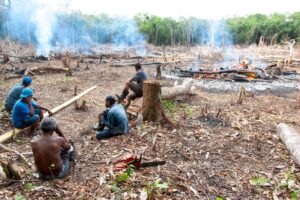Welcome to Carbon Brief’s DeBriefed.
An essential guide to the week’s key developments relating to climate change.
This week
COP crunch
FINAL CALL: COP29 has entered its final scheduled day in Baku. Yesterday’s six-hour “Qurultay” meeting witnessed “unanimous” disappointment over the state of draft texts, with developing countries unhappy about the lack of numbers on climate finance and almost all calling for clearer language on climate action. (Carbon Brief’s Simon Evans live-posted highlights from the event.) Around 3pm local time today, the COP29 presidency released a package of new texts, just hours before talks were due to close. At least one further iteration is expected.
FINANCE FIGHT: The new proposal for a global climate finance goal would involve developed countries “taking the lead” in channelling $250bn a year by 2035 to “help poorer nations” deal with climate change, Reuters reported. It added that the proposal has drawn criticism “from all sides”. Politico noted that it “falls far short of the trillion-plus figure that the poorer countries had sought”. For more on the draft finance deal, see Spotlight below.
STOCKTAKE STUTTERS: Last year’s “global stocktake” at COP28 included the landmark deal to “transition away from fossil fuels”. But the latest draft on the “mitigation work programme” excised all links back to this. Carrying things forward has been left to the “UAE dialogue”, which, in its latest draft, “reaffirms” last year’s language on fossil fuels, renewables and energy efficiency. It also has optional text adding further goals on energy storage and grids, as well as requesting an annual progress report for debate at subsequent COPs.
WILL IT END?: Seasoned COP watchers will know that the talks almost always run past their scheduled finish time. Carbon Brief’s analysis of previous finish times suggests that, if COP29 follows the upward trend, it will end at 3.25am on Sunday morning. Carbon Brief also polled a group of more than 200 delegates to ask when they think COP29 will end, with the mean time selected being 1:34am on Sunday. After talks finally draw to a close, Carbon Brief journalists will hold a free webinar to discuss the key outcomes. Sign up.
Around the COP
- ARGENTINA STAYS: Argentina confirmed it will not leave the Paris Agreement, squashing rumours ignited after right-wing populist leader Javier Milei decided to withdraw his country’s delegation from the talks last week, El Observador reported.
- INDONESIAN TRANSITION: Indonesia’s president Prabowo Subianto announced plans to retire all coal and other fossil-fuel power stations within 15 years, while also aiming to bring the nation’s net-zero target forward by a decade, said the Associated Press. It said experts “welcomed” the ambition, but are “sceptical” of its delivery.
- POWER PLAY: The UK launched a “global clean power alliance” at the G20, with Brazil, Australia, Canada and France among members, according to the Press Association. The leaders of the UK and Brazil wrote joint op-eds touting the pact in the Times and Folha de São Paulo.
- COP ‘STAND-OFF’: Australia and Turkey are currently in a “stand-off” over who will host COP31 in 2026, with neither party willing to give up their bid, Reuters said.
- ‘BIZARRE’ RESTRICTIONS: COP29 host Azerbaijan went to “bizarre” lengths to prepare Baku for the summit, Bloomberg reported. This included clearing public areas and roads by moving parliamentary elections, shutting schools and universities and ordering two-thirds of the city to work from home.
- LOBBYISTS: A Global Witness investigation found that at least 1,700 fossil-fuel executives registered to attend COP29, lower than the record in Dubai, but still larger than most party delegations. The Guardian reported that “hundreds” of industrial farming lobbyists have also been in attendance.
Zero
The number of new countries at COP29 joining a small alliance of nations that have pledged to phase out oil and gas.
Latest climate research
- Climate lawsuits and negative court decisions can reduce the value of publicly listed companies, a Nature Sustainability study suggested.
- Early 20th century global ocean surface temperatures were warmer than previously thought, a study in Nature has found, meaning the pace of heating from 1900 to the 1950s was slightly slower than assumed.
- A Nature Geoscience study found that the weakening of the Atlantic Meridional Overturning Circulation (AMOC) – a major system of ocean currents responsible for transporting heat around the world – could be linked to influxes of freshwater into the subarctic Atlantic.
(For more, see Carbon Brief’s in-depth daily summaries of the top climate news stories on Monday, Tuesday, Wednesday, Thursday and Friday.)
Captured

China’s historical emissions within its borders have now caused more global warming than the 27 member states of the EU combined, according to new Carbon Brief analysis. However, China is still far behind the world’s largest historical emitter, the US, the analysis showed. It added that China is unlikely to ever overtake the US, based on current policies, committed plans and technology trends in both countries. Carbon Brief’s analysis is featured in a data-driven article in the New York Times.
Spotlight
Decoding the COP29 finance proposal
Carbon Brief unravels the latest hotly contested climate-finance text from COP29 and explains the main sticking points.
Nations have a deadline at COP29 to agree on a new goal for channelling money into cutting emissions and protecting people from climate change.
This target will replace an existing obligation for “developed” countries – including EU states, the US and Japan – to provide $100bn of climate finance a year to “developing” countries.
Money has always been one of the most controversial aspects of UN climate talks and COP29 has exposed deep rifts.
A draft text outlining the new goal published earlier today shows that, on the day the talks are meant to finish, these tensions are far from being resolved. Developing countries and climate NGOs described the proposal as “totally unacceptable” and a “joke”.
Parties will now digest this text and at least one new version will be produced by the Azerbaijani presidency as the talks drag into overtime.
Billions

The proposed goal has two parts. At its core is $250bn delivered each year to developing countries by 2035.
This is framed as the continuation of the $100bn annual goal, which is provided entirely by developed countries. Yet, in this text, developed countries only “take the lead”, leaving the goal open for others to contribute.
As with the $100bn, this goal would include public money, such as development aid, as well as private finance that is “mobilised” by public spending.
The target matches one floated to Politico by EU sources earlier in the week, which was greeted with derision by global-south leaders. Developing countries had demanded a similar core goal of $440-900bn, but made up entirely of public money and largely as grants.
Crucially, analysts have found that comparable amounts of climate finance could be provided in this timeframe, even if developed countries make no extra effort to contribute more in the coming years, beyond existing commitments.
Trillions

From the start of COP29, all developing countries have been united behind a call for $1.3tn in climate finance a year, provided by developed countries.
There is broad agreement among experts that developing countries need to invest trillions of dollars each year to fulfil their climate goals, with large chunks coming from developed countries.
The new text includes a “call” to raise $1.3tn in climate finance by 2035.
However, it does not line up with developing countries’ proposals and, instead, reflects developed countries’ long-standing vision of a broader goal based on global “investment”. It refers to the $1.3tn coming from “all public and private sources”.
On the other hand, some of the more contentious ideas put forward by developed countries, such as the US, are no longer in the text. For example, it does not reference “domestic spending” in counting towards the goal.
Contributors

One of the most disputed topics in climate-finance talks has been expanding the list of contributors beyond developed countries.
Many nations classed as “developing” in the UN climate system, such as China and Saudi Arabia, are relatively wealthy and major contributors to climate change. This, some argue, means they should be obliged to provide finance.
There is no longer a formal recognition of this in the new text. An attempt by some developed countries to add criteria for new contributors was deleted the previous day.
COP29 has seen some wrangling around this issue. Observers welcomed China referencing the billions of dollars in climate funds it already provides to the global south and the EU expressed its openness to recognising “voluntary” contributions from developing countries.
In the end, the draft text “invites” developing countries to contribute. It also references “voluntary” counting of contributions from multilateral development banks, to which emerging economies provide large sums of money.
The climate-finance text contains many more notable compromises, which are summarised in this thread. All eyes are now on what the final text, agreed by all parties at COP29, will say.
Watch, read, listen
‘TRUMP ATE MY HOMEWORK’: A comment piece by Avantika Goswami in Down to Earth picked apart the “narrative of a prejudged failed COP” in a crucial year for climate finance.
‘GRANTS, NOT LOANS’: The Green Pulse podcast by Singapore’s Straits Times explained what the COP29 finance goal means and why more “loans can’t help” vulnerable communities in developing countries.
ASIAN AGE: Historian and author Adam Tooze discussed climate, trade wars, geopolitics and the “polycrisis” in Asia in his State of Asia 2024 address.
Coming up
- 25-27 November: UN Forum on Business and Human Rights, Geneva, Switzerland
- 25 November-1 December: Fifth session of negotiations for an international plastics treaty (INC 5), Busan, South Korea
- 2-13 December: International Court of Justice hearings on the obligations of states in respect of climate change, The Hague, Netherlands
- 2-13 December: UN Desertification Conference COP16, Riyadh, Saudi Arabia
Pick of the jobs
- Small World, senior sustainability consultant | Salary: £49,811-£67,000. Location: Lancaster (hybrid)
- The Ocean Census, head of science | Salary: £78,000. Location: Oxford, UK
- M+ Museum, head of conservation and research | Salary: Unknown. Location: Hong Kong
- Associated Press, oceans and climate reporter | Salary: Unknown. Location: Los Angeles, US
- The Environmental Reporting Collective, managing editor | Salary: Unknown. Location: Southeast Asia
DeBriefed is edited by Daisy Dunne. Please send any tips or feedback to debriefed@carbonbrief.org.
This is an online version of Carbon Brief’s weekly DeBriefed email newsletter. Subscribe for free here.
The post COP29 DeBriefed 22 November 2024: Countries split on climate finance; Fossil-fuel transition ‘reaffirmed’; Latest texts analysed appeared first on Carbon Brief.
Climate Change
UN report: Five charts showing how global deforestation is declining
The amount of forest lost around the world has reduced by millions of hectares each year in recent decades, but countries are still off track to meet “important” deforestation targets.
These are the findings of the Global Forest Resources Assessment – a major new report from the UN’s Food and Agriculture Organization – which says that an estimated 10.9m hectares (Mha) of land was deforested each year between 2015 and 2025.
This is almost 7Mha less than the amount of annual forest loss over 1990-2000.
Since 1990, the area of forest destroyed each year has halved in South America, although it still remains the region with the highest amount of deforestation.
Europe was the only region in the world where annual forest loss has increased since 1990.
Agriculture has historically been the leading cause of deforestation around the world, but the report notes that wildfires, climate change-fuelled extreme weather, insects and diseases increasingly pose a threat.
The Global Forest Resources Assessment is published every five years. The 2025 report compiles and analyses national forest data from almost every country in the world over 1990-2025.
Carbon Brief has picked out five key findings from the report around deforestation, carbon storage and the amount of forest held within protected areas around the world.
1. Rates of deforestation are declining around the world
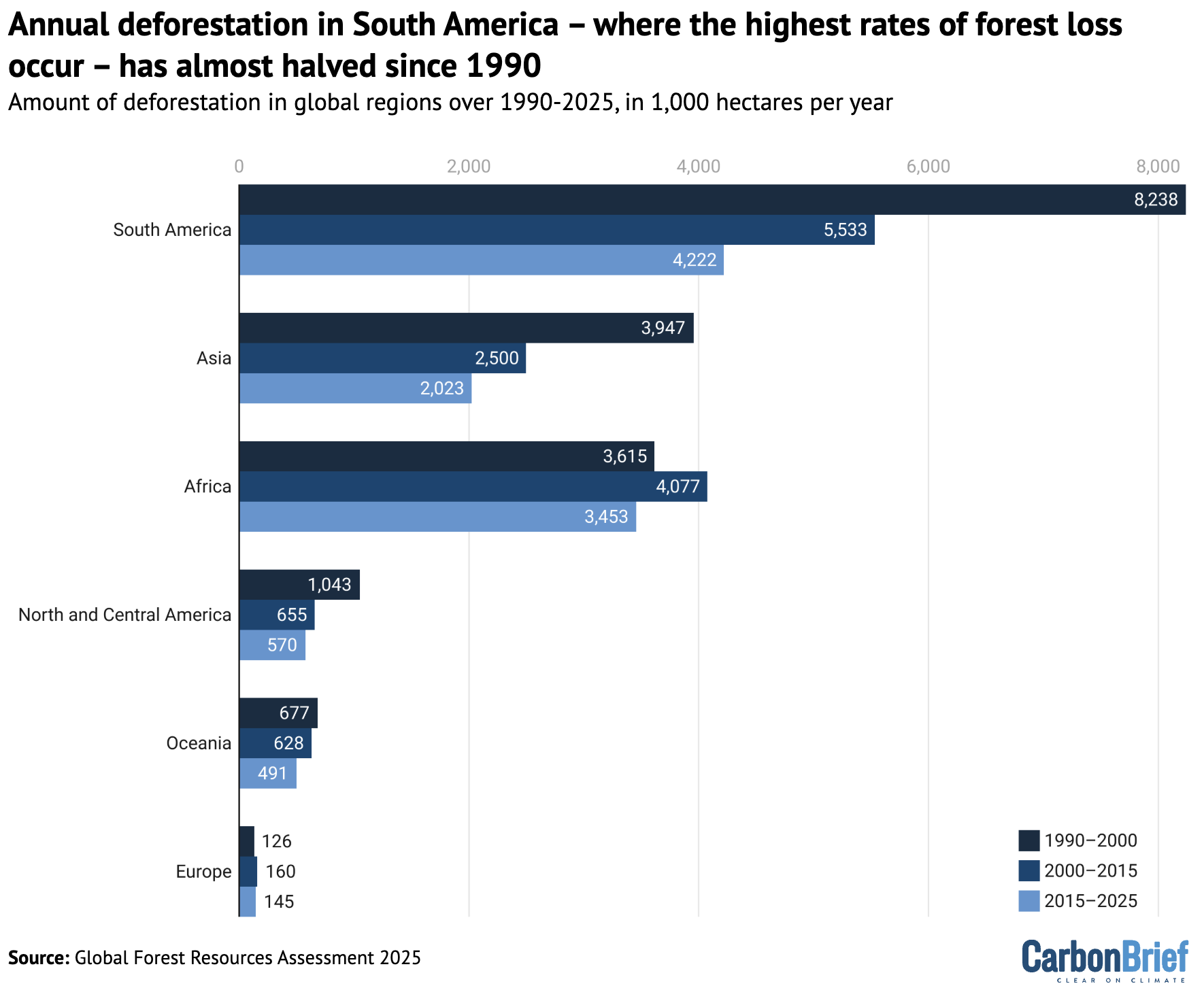
Rates of annual deforestation, in thousands of hectares, in South America, Asia, Africa, North and Central America, Oceania and Europe over 1990-2000 (dark blue), 2000-15 (medium blue) and 2015-25 (light blue). Source: Global Forest Resources Assessment 2025
In total, around 489Mha of forest have been lost due to deforestation since 1990, the new report finds. Most of this – 88% – occurred in the tropics.
This breaks down to around 10.9Mha of forest lost each year between 2015 and 2025, a reduction compared to 13.6Mha of loss over 2000-15 and 17.6Mha over 1990-2000.
Deforestation refers to the clearing of a forest, typically to repurpose the land for agriculture or use the trees for wood.
The chart above shows that South America experiences the most forest loss each year, although annual deforestation levels have halved from 8.2Mha over 1990-2000 to 4.2Mha over 2015-25.
Annual deforestation in Asia also saw a sizable reduction, from 3.9Mha over 1990-2000 to 2Mha over 2015-25, the report says.
Europe had the lowest overall deforestation rates, but was also the only region to record an increase over the last 35 years, with deforestation rates growing from 126,000 hectares over 1990-2000 to 145,000 hectares in the past 10 years.
Despite the downward global trend, FAO chief Dr Qu Dongyu notes in the report’s foreword that the “world is not on track to meet important global forest targets”.
In 2021, more than 100 countries pledged to halt and reverse global deforestation by 2030. But deforestation rates in 2024 were 63% higher than the trajectory needed to meet this 2030 target, according to a recent report from civil society groups.
The goals of this pledge were formally recognised in a key text at the COP28 climate summit in Dubai in 2023, which “emphasise[d]” that halting and reversing deforestation and forest degradation by 2030 would be key to meeting climate goals.
2. Global net forest loss has more than halved since 1990
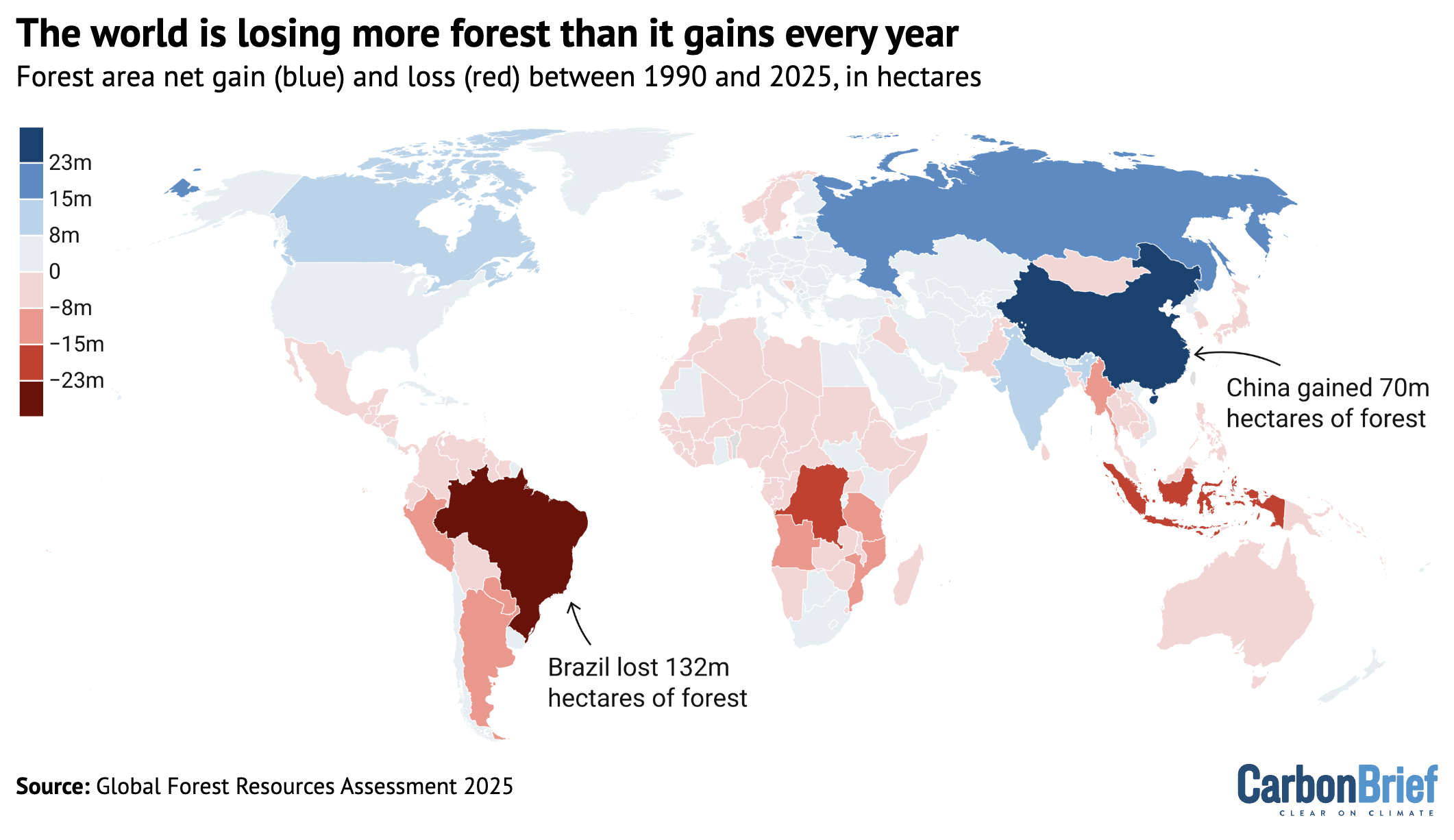
Forest area net change by country between 1990 and 2025, in hectares. Source: Global Forest Resources Assessment 2025
The new report finds that forests cover more than 4bn hectares of land, an area encompassing one-third of the planet’s land surface.
More than half of the world’s forested area is located in just five countries: Russia, Brazil, Canada, the US and China.
The map above shows that, overall, more forest is lost than gained each year around the world. There was 6.8Mha of forest growth over 2015-25, but 10.9Mha of forest lost.
The annual rate of this global net forest loss – the amount that deforestation has exceeded the amount regrown – has more than halved since 1990, dropping from 10.7Mha over 1990-2000 to 4.1Mha over 2015-25.
The report says this change was due to reduced deforestation in some countries and increased forest expansion in others. However, the rate of forest expansion has also slowed over time – from 9.9Mha per year in 2000-15 to 6.8Mha per year in 2015-25.
There are many driving factors behind continuing deforestation. Agriculture has historically been the leading cause of forest loss, but wildfire is increasingly posing a threat. Wildfires were the leading driver of tropical forest loss in 2024 for the first time on record, a Global Forest Watch report found earlier this year.
The new UN report says that an average of 261Mha of land was burned by fire each year over 2007-19. Around half of this area was forest. Around 80% of the forested land impacted by fires in 2019 was in the subtropics – areas located just outside tropical regions, such as parts of Argentina, the US and Australia.
The report notes that fire is widely used in land management practices, but uncontrolled fires can have “major negative impacts on people, ecosystems and climate”.
It adds that researchers gathered information on fires up as far as 2023, but chose to focus on 2007-19 due to a lack of more recent data for some countries.
A different report from an international team of scientists recently found that fires burned at least 370Mha of land – an area larger than India – between March 2024 and February 2025.
3. Many countries are hugely increasing their forest area
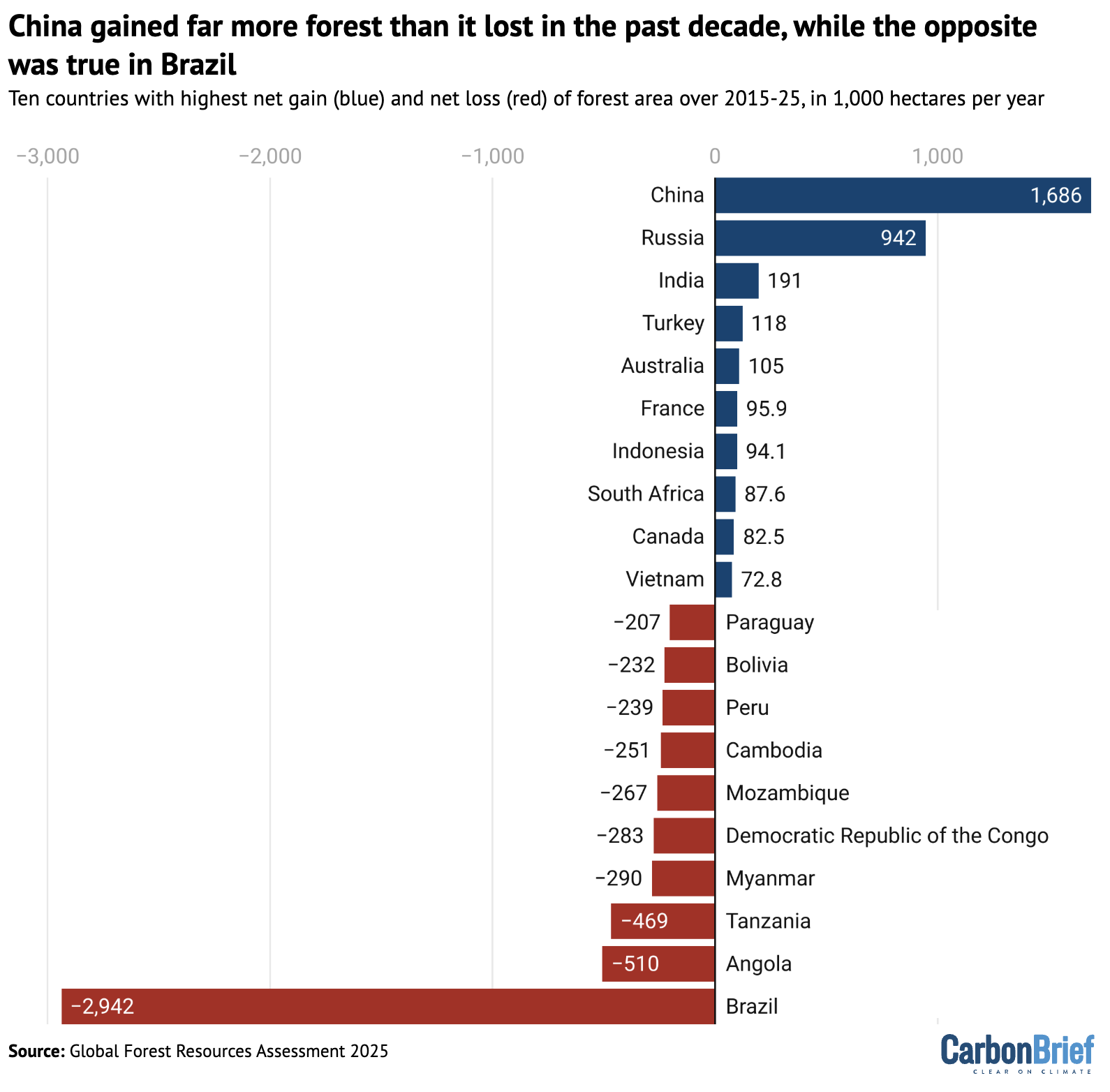
Top 10 countries for annual net gain (blue) and net loss (red) of forest area over 2015-25, in 1,000 hectares per year. Source: Global Forest Resources Assessment 2025
Globally, deforestation is declining, but the trend varies from country to country.
The chart above shows that some nations, such as China and Russia, added a lot more forest cover than they removed in the past decade through, for example, afforestation programmes.
But in other countries – particularly Brazil – the level of deforestation far surpasses the amount of forest re-grown.
Deforestation in Brazil dropped by almost one-third between 2023 and 2024, news outlet Brasil de Fato reported earlier this year, which was during the time Luiz Inácio Lula da Silva took over as president. The new UN report finds that, on average, Brazil lost 2.9Mha of forest area each year over 2015-25, compared to 5.8Mha over 1990-2000.
Russia’s net gain of forest cover increased significantly since 1990 – growing from 80,400ha per year in 1990-2000 to 942,000ha per year in 2015-25.
In China, although it is also planting significant levels of forest, the forest level gained has dropped over time, from 2.2Mha per year in 2000-15 to 1.7Mha per year in 2015-25.
Levels of net forest gain in Canada also fell from 513,000ha per year in 2000-15 to 82,500ha per year in 2015-25.
In the US, the net forest growth trend reversed over the past decade – from 437,000ha per year of gain in 2000-15 to a net forest loss of 120,000ha per year from 2015 to 2025.
Oceania reversed a previously negative trend to gain 140,000ha of forests per year in the past decade, the report says. This was mainly due to changes in Australia, where previous losses of tens of thousands of hectares each year turned into an annual net gain of 105,000ha each year by 2015-25.
4. The world’s forests hold more than 700bn tonnes of carbon
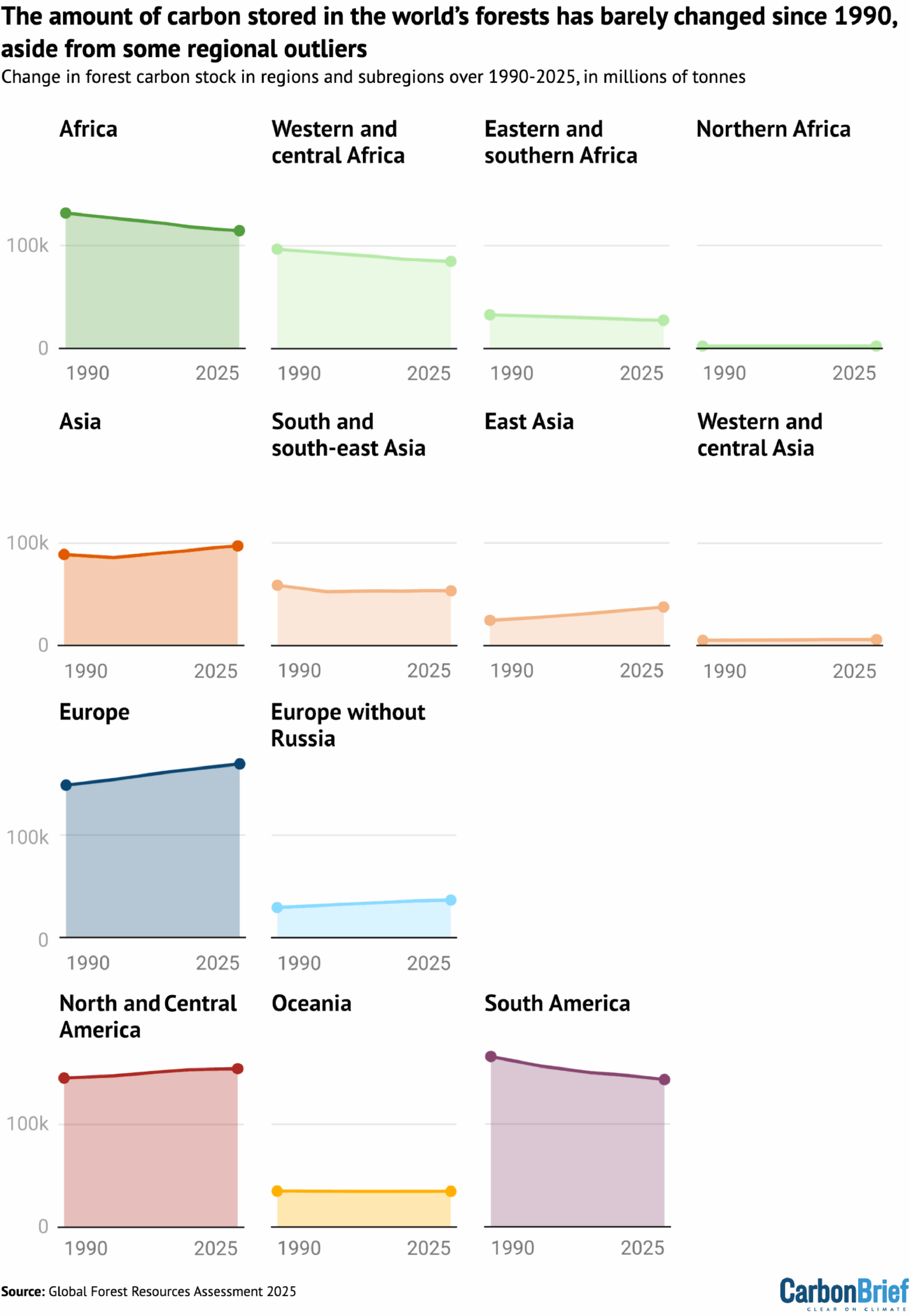
Changes in forest carbon stock by region and subregion of the world over 1990-2025. Source: Global Forest Resources Assessment 2025
The “carbon stock” of a forest refers to how much carbon is stored in its trees and soils. Forests are among the planet’s major carbon sinks.
The new report estimates that forests stored an estimated 714bn tonnes, or gigatonnes, of carbon (GtC) in 2025.
Europe (including Russia) and the Americas account for two-thirds of the world’s total forest carbon storage.
The global forest carbon stock decreased from 716GtC to 706GtC between 1990 and 2000, before growing slightly again by 2025. The report mainly attributes this recent increase to forest growth in Asia and Europe.
The report notes that the total amount of carbon stored in forests has remained largely static over the past 35 years, but with some regional differences, as highlighted in the chart above.
The amount of carbon stored in forests across east Asia, Europe and North America is “significantly higher” now due to expanded forest areas, but it is lower in South America, Africa and Central America.
Several studies have shown that there are limitations on the ability of forests to keep absorbing CO2, with difficulties posed by hotter, drier weather fuelled by climate change.
A 2024 study found that record heat in 2023 negatively impacted the ability of land and ocean sinks to absorb carbon – and that the global land sink was at its weakest since 2003.
Another study, published in 2022, said that drying and warming as a result of deforestation reduces the carbon storage ability of tropical forests, especially in the Congo basin and the Amazon rainforest.
5. Around one-fifth of the world’s forests are located in protected areas
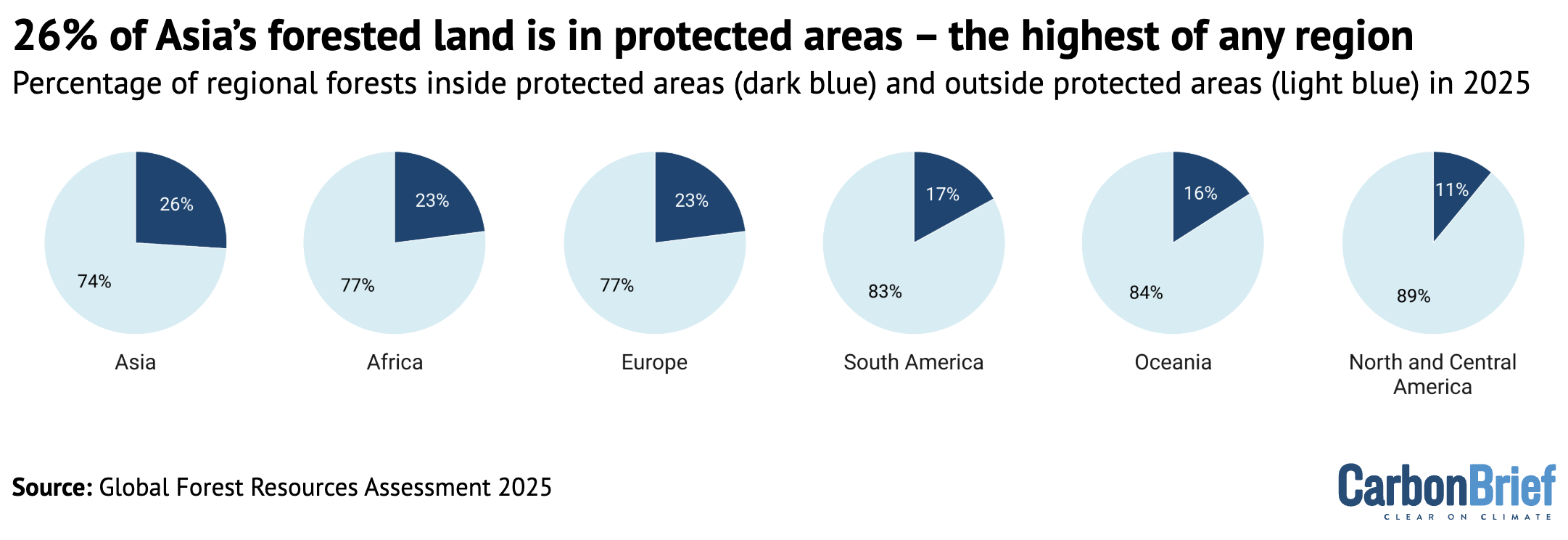
The percentage of forest land in Asia, Africa, Europe, South America, Oceania and North and Central America contained inside protected areas (dark blue) and outside protected areas (light blue) in 2025. Source: Global Forest Resources Assessment 2025
The amount of forested land located in protected areas increased across all regions between 1990 and 2025.
For an area to be considered “protected”, it must be managed in a way that conserves nature.
Around 20% of the world’s forests are located in these protected areas, the new report finds, which amounts to 813Mha of land – an area almost the size of Brazil.
Nearly every country in the world has pledged to protect 30% of the Earth’s land and sea by 2030. However, more than half of countries have not committed to this target on a national basis, Carbon Brief analysis showed earlier this year.
Almost 18% of land and around 8% of the ocean are currently in protected areas, a UN report found last year. The level is increasing, the report said, but considerable progress is still needed to reach the 2030 goal.
The new UN report notes that Europe, including Russia, holds 235Mha of protected forest area, which is the largest of any region and accounts for 23% of the continent’s total forested land.
As highlighted in the chart above, 26% of all forests in Asia are protected, which is the highest of any region. The report notes that this is largely due to a vast amount of protected forested land in Indonesia.
Three countries and one island territory reported that upwards of 90% of their forests are protected – Norfolk Island, Saudi Arabia, Cook Islands and Uzbekistan.
The post UN report: Five charts showing how global deforestation is declining appeared first on Carbon Brief.
UN report: Five charts showing how global deforestation is declining
Climate Change
Federal Appeals Court Pauses Litigation Over Florida’s Alligator Alcatraz
The Trump administration had sought the stay of proceedings in the case, arguing its attorneys were furloughed during the government shutdown. The plaintiffs say the administration is picking and choosing which cases to litigate.
A federal appeals court paused litigation Wednesday brought by environmental groups over Florida’s Alligator Alcatraz, the hastily assembled Everglades detention site where the Trump administration aims to incarcerate and deport thousands of undocumented migrants.
Federal Appeals Court Pauses Litigation Over Florida’s Alligator Alcatraz
Climate Change
Breach of Contract or Constitutional Crisis?
An appellate court will determine how to handle the Trump administration’s cancellation of hundreds of climate and environmental justice grants.
The U.S. Fourth Circuit Court of Appeals in Richmond, Virginia, heard arguments Thursday on whether the Trump administration’s cancellation of billions of dollars in environmental and climate grants earlier this year violated the Constitution or was merely a contract dispute.
-
Climate Change2 years ago
Spanish-language misinformation on renewable energy spreads online, report shows
-
Climate Change2 months ago
Guest post: Why China is still building new coal – and when it might stop
-
Climate Change Videos2 years ago
The toxic gas flares fuelling Nigeria’s climate change – BBC News
-

 Greenhouse Gases1 year ago
Greenhouse Gases1 year ago嘉宾来稿:满足中国增长的用电需求 光伏加储能“比新建煤电更实惠”
-
Greenhouse Gases2 months ago
Guest post: Why China is still building new coal – and when it might stop
-

 Climate Change1 year ago
Climate Change1 year ago嘉宾来稿:满足中国增长的用电需求 光伏加储能“比新建煤电更实惠”
-

 Carbon Footprint2 years ago
Carbon Footprint2 years agoUS SEC’s Climate Disclosure Rules Spur Renewed Interest in Carbon Credits
-
Renewable Energy3 months ago
US Grid Strain, Possible Allete Sale




